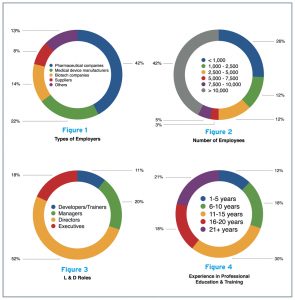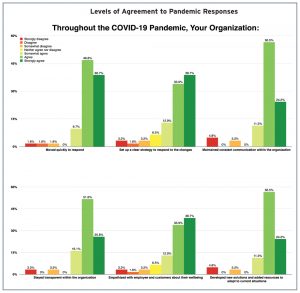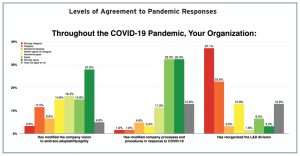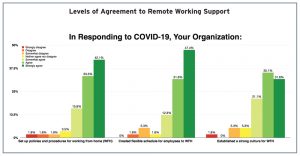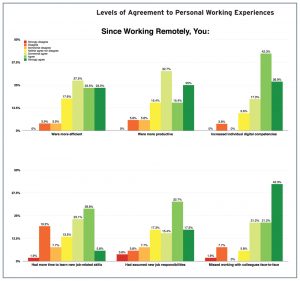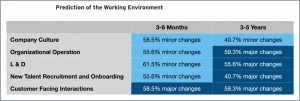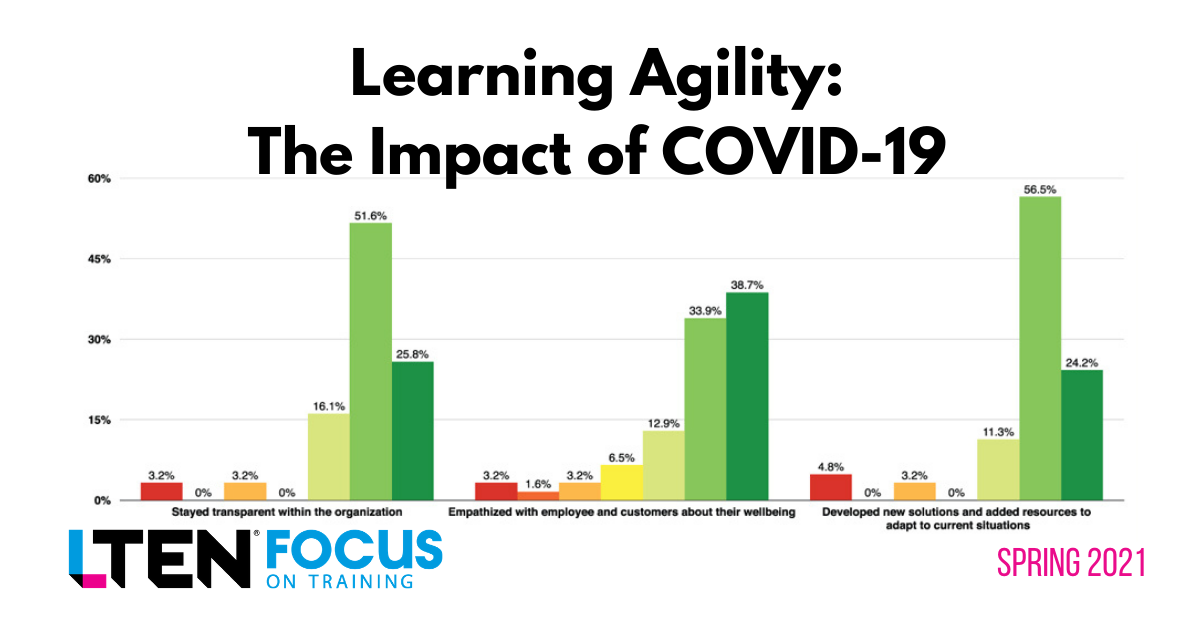
Learning Agility: The Impact of COVID-19
Feature Story – By XinYun Peng, Nicole Wang-Trexler, Ph.D., and Kyle Peck, Ph.D.
During 2020, almost every organization evolved, shifting in several ways to address the pandemic. As the coronavirus continuously spreads, many organizations still have not set a definite date to return to their physical offices. Organizations in the life sciences sector were among the earliest hit by the effects of the pandemic, and their learning and development (L&D) personnel and practices were among the most dramatically affected, as many were severely disrupted by the loss of the ability to conduct face-to-face training.
LTEN and Penn State University have embarked on a joint research collaboration,
titled “Learning Agility: The Impacts and Effects of COVID-19,” during which we
interviewed seasoned L&D professionals, finding that a new, agile working mode
was needed and has been implemented by many organizations. We also found
that some L&D professionals lacked the design skills needed to transform
traditional learning materials to the online-only environment, and that leadership
development and sales training departments needed new models to be effective in virtual environments.
Despite these significant challenges, most participants interviewed were satisfied with how their organizations had handled the shift overall.
Based on the initial insights we collected from interviews, we conducted a followup survey incorporating people from different organizations and holding a variety of positions to examine their perceptions of their experiences during this time of great change. This article summarizes and synthesizes the survey results.
Some results are aligned with the themes from the interviews, some extended the themes and some others provided new insights. The information you’ll find in this study may help you guide your organization as you move into an increasingly agile learning future, as you compare the actions being taken by your organization with those experienced by L&D professionals in the areas of organizational leadership, human resources strategies, organizational development, innovation and how L&D might reshape the field’s future.
Respondents’ Demographics
Our respondents included participants who work for medical device manufacturers (22.5%), pharmaceutical companies (42.3%), biotech companies (14.1%), suppliers (8.5%), and other types of organizations, including training companies, consulting firms and labs. Approximately 42% of the participants worked in companies that have more than 10,000 employees. Among these organizations, 62.1% were entirely U.S.- based organizations, and 57.6% of them were not directly involved in COVID-19 diagnostics or treatment. (See Figures 1 and 2.)
Respondents were in different roles within their companies’ L&D teams. About 51.5% were in director-level positions, 19.7% were managers, 18.2% were executives, and 10.6% were developers or trainers. The majority of the participants were experienced professionals in the L&D field. Seventy percent had 11 or more years of experience, and 21.2% of all participants had 21 or more years of experience. (See Figures 3 and 4.)
Positive Attitudes
Respondents were satisfied with the overall reactions of the leadership of their organizations toward the pandemic, with 86% or more providing supportive responses. Ninety-three percent agreed that the leadership moved quickly, and 86% reported that their leaders had set up a clear strategy. Respondents stated that all levels, from global C-suite, U.S. business unit to individual organization structures, maintained constant communication, felt that their leadership led with empathy and reported that the organization developed new resources quickly to adapt to current situations.
Similarly, more than half of the respondents (59.1%-75.9%) agreed that their organizations had modified the company vision, processes and procedures to embrace adaptability, and had an increased a sense of social responsibility. However, most of them (62.9%) disagreed that their organizations had reorganized the L&D division. Besides the leadership, some respondents also showed positive attitudes toward their colleagues and peers by commenting that they were proud of the cross-functional collaborations and the efficiency of working together. (See Figure 5, 6 and 7.)
Increased Productivity & Competency
Organizations had made efforts to allow working from home (WFH) to be smoothly transitioned and effective for employees and customers. (See Figure 8.) According to the respondents’ ratings, most agreed (87.8%-91.3%) that their organizations set up policies, created flexible schedules and established strong cultures for the WFH situation. One respondent stated that they felt the virtual environment was supported.
Although some respondents (57.9%) perceived that their organizations viewed WFH as temporary, most respondents (70.2%) still thought their organizations would consider WFH as a long-term strategy even after the pandemic. Most respondents (82.1%-96.4%) acknowledged that organizations had
created solutions to meet clients’ current needs by modifying or designing new products and services and leveraging technologies. One respondent mentioned that any technology that was used by customers must meet their needs first and foremost, and another felt a greater emphasis put on supporting individuals and teams.
Respondents’ attitudes leaned significantly more toward the positive side about the performance of their customer-facing employees and field teams. More than 90% of the respondents perceived that their customer-facing employees and field teams had increased digital selling competency, and 79% of the respondents perceived that these colleagues had more time to participate in trainings. However, more respondents disagreed (45.6%) than agreed (38.7%) that their customer-facing employees had engaged with more customers than before COVID-19.
In terms of individual experiences, respondents generally had treated WFH positively. (See Figures 9 and 10.) A majority (73.1%-86.5%) of the respondents reflected that they had become more efficient and productive, and they gained digital competencies since WFH. Comparatively fewer respondents (57.7%) perceived that they had more time to learn new things related to their jobs. Some respondents addressed that they had been working remotely before COVID-19, so they had always felt productive working in this way. However, most respondents (65.4%) realized they had assumed new job responsibilities, and they (84.7%) missed working with colleagues face to face.
Reskilling/Upskilling
Less than 10% of respondents reported downsizing within their organizations’ L&D departments. Within the 10%, 60% attributed the downsizing to budget cuts. Only 12.7% of all respondents reported that their L&D budget had increased somewhat, and the rest had experienced either no budget change or decreased budget.
Most of these professionals had to reskill or upskill to meet customers’ emerging needs. More than half of our respondents (50.9%) reported that their organizations had not hired new talent since the pandemic, while most respondents (83.7%-85.5%) had participated in the reskilling and upskilling opportunities related to digital competency either through virtual microlearning provided by their employer or by upskilling experiences on their own. Video conferencing tools, tools to engage customers and tools to help learners with information recall were ranked as the top three most frequently used technologies and were also perceived to be the most valuable. Several respondents reported that there had been a hiring freeze since the early months. Some others reported that their organizations deployed classes for upskilling, such as virtual selling skills class and onboarding for just-in-time learning.
Almost all trainings and curricula had moved online. Approximately three-fourths of the respondents (72.2%-75.9%) reported that their onboarding process, knowledge-based training and sales-related skills training had been completely moved online. Among the remaining quarter of respondents, most of their training and curricula were either already all online prior to COVID or partly moved online. Less than 4% of the respondents voted for “not changed since the pandemic.”
Similar patterns were observed in the soft-skills-related trainings: 66.7% of the respondents thought leadership-related skills training and power skills training had been moved online completely, and 50% of them thought compliance training had been moved online completely.
The New Normal
Respondents predicted a new normal in the future as the working mode. (See Table 1.) Only 17% of respondents believed that this field would go back to pre-COVID training modes. The majority (58.5%) believed that more organizational goals would be accomplished online even after COVID, and 17% of them believed that the pandemic triggered a paradigm shift and an evolution of this field.
In the short-term (three to six months), more than half of the respondents (55.6%-61.5%) thought that there would be minor, rather than major, changes in company cultures, organizational operations, L&D and recruitment and onboarding processes; and there would be major changes in customer-facing interactions. On the other hand, in the long-term (three to five years), more respondents (40.7%-59.3%) tended to think there would be major changes in organizational operations, L&D, recruitment and onboarding and customer-facing interactions.
Key Takeaways
In conclusion, here are the key messages emerging from this study:
- In general, respondents reported positive perceptions toward their organizations’ responses to COVID.
- Respondents (57.7%-74.5%) perceived high productivity and increased digital competencies while working remotely.
- Although some respondents (57.9%) believed working from home is temporary, most (70.2%) predicted it would be a long-term strategy for some employees.
- Respondents reported upskilling and reskilling due to working from home and in preparation for virtual training.
- Video conferencing tools, tools to engage customers and tools to help learners with information recall were ranked as the most frequently used technologies and were also perceived to be the most valuable.
- Respondents all believed a new normal would persist after COVID.
- Although respondents did not perceive a major change under way in the short-term, they all perceived that major changes would occur in the long-term.
If you have any questions or comments regarding the above article or this research project, please feel free to contact LTEN/PSU graduate research fellows Xinyun Peng at xypeng@psu.edu and Nicole Wang-Trexler at nicolewang12@gmail.com.

